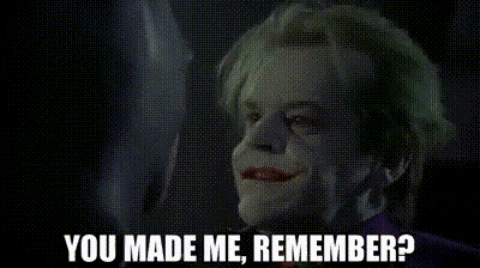“The opening story frame brought us into the home of Commissioner Gordon, currently entertaining his “YOUNG SOCIALITE FRIEND, BRUCE WAYNE,” a bored young man who puffs heroically on a pipe while asking the question “WELL, COMMISSIONER, ANYTHING EXCITING HAPPENING THESE DAYS?” The middle-aged police chief was a keen smoker too, igniting a cigar that sent a miniature mushroom cloud into the air between the two.
“NO-O-,” Gordon began tentatively. Then, as if the most intriguing element of the story were a mere afterthought: “EXCEPT THIS FELLOW THEY CALL THE ‘BAT-MAN’ PUZZLES ME.”
When Gordon was summoned to the scene of a brutal murder at a nearby mansion, Wayne tagged along, as if there was nothing at all odd about a member of the public who treated deathly serious police investigations as sightseeing trips.
Bat-Man appeared on the third page, standing on the roof in the moonlight. His stance displayed confidence; his arms were folded, and he seemed unafraid, almost laconic. The crooks recognized him, cuing readers that this adventure was not the first night out for our hero. As with Superman, we arrived after the story had already begun, groping for our seats in the dark. Almost immediately, Batman erupted into violence against the men in a rapid sequence of action panels.

In his first outing, he broke up the bizarrely complex plot of a chemical syndicate involving several murders and some money. It’s not a great story, and no matter how often I read it, I’m still left slightly in the dark as to what it was about, but the striking appearance of the hero made it unforgettable. It also established an important trend in the early Batman stories. From the very beginning, Batman habitually found himself dealing with crimes involving chemicals and crazy people, and over the years he would take on innumerable villains armed with lethal Laughing Gas, mind-control lipstick, Fear Dust, toxic aerosols, and “artificial phobia” pills. Indeed, his career had barely begun before he was heroically inhaling countless bizarre chemical concoctions cooked up by mad blackmarket alchemists. Superman might have faced a few psychic attacks, but, even if it was against his will every time, Batman was hip to serious mind-bending drugs. Batman knew what it was like to trip balls without seriously losing his shit, and that savoir faire added another layer to his outlaw sexiness and alluring aura of decadence and wealth.

In July 1939’s Detective Comics no. 29, he faced another drug-dispensing no-gooder in “The Batman Meets Doctor Death.” Doctor Death was Karl Hellfern, a seriously disgruntled middle-aged chemist and obviously a devious bastard, as indicated by the presence of a monocle. Unable to rustle up even the simplest of hair-restoring formulas, he was seriously balding but sported a devilish goatee and pointed ears, which may or may not have been hereditary. In this adventure, Batman was shot and wounded, showing that, unlike Superman, he was as mortal as the rest of us, only much more tenacious.

The ending to the story found a new note of hysteria that would enliven the best Batman adventures: trapped in his laboratory, Doctor Death fought back by inadvertently setting the whole place alight. As he realized what he’d done and was consumed by flames, the doctor lost it completely, screaming, “HA! HA! OH—HA-HA-HA—YOU—YOU FOOL!” To which Batman, pausing a moment to watch the spreading inferno, replied grimly, “YOU ARE THE POOR FOOL! HE HAS GONE MAD! DEATH … TO DOCTOR DEATH!”
The introduction of the secret identity, given away so generously as just one more brilliant idea halfway through the first Superman story, was saved for the twist ending of the third Batman story, which kept it in line with the mystery and detective aspects of the Batman strip.
The last two panels showed a door, creaking open from its curious position ajar until the “Bat-Man” stood revealed in full costume. There’s something genuinely strange about this dreamlike conclusion to the story, this weird emergence from the closet into the half-light. It seemed a miracle that Wayne, our chain-smoking pipe abuser, could wheeze his way out of the cupboard and down the hall, let alone spring and glide across the rooftops of Gotham, but the distinctive visual of Batman was so arresting, so visceral, he caught on with the reading public as rapidly as Superman had.”
Excerpt From
Supergods
Grant Morrison

